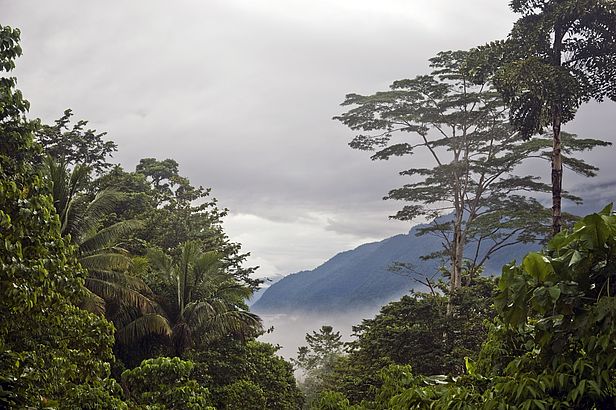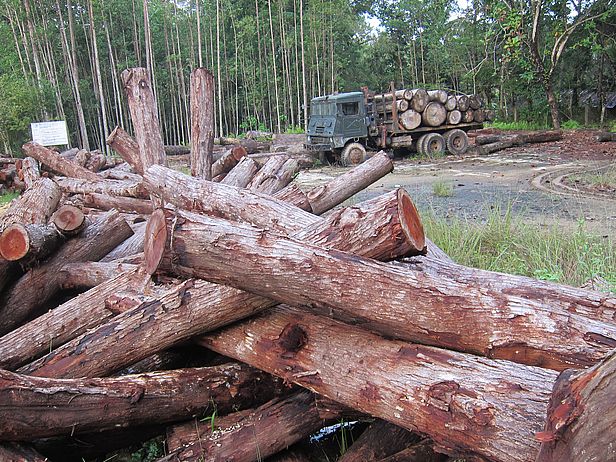29.04.2021 | Lisa Bose | News WSL
The area of tropical montane cloud forests is shrinking worldwide. An international research team led by the Swiss Federal Institute for Forest, Snow and Landscape Research WSL has been able to prove this for the first time with the help of satellite data. The decline is associated with an immense loss of plants and animals. Protected areas have hardly any effect.
Cloud forests are among the most species-rich habitats in the world. But the area of these forests, which only occur in the tropics, is steadily decreasing, and with it the diversity of plants and animals that depend on this unique habitat. An international research team of biologists from WSL Birmensdorf and the Center for Biodiversity and Global Change at Yale University, USA, has been able to demonstrate the decline for the first time with the help of satellite data. The results, which the researchers published in the scientific journal Nature Ecology and Evolution, show that the decline does not stop at protected areas.
Since data on the global distribution of cloud forests was previously lacking, study first author Dirk Karger and his colleagues from Switzerland, Germany and the USA combined the high-resolution climate dataset CHELSA, which is maintained at WSL, with data on global cloud cover. This allowed the researchers to estimate where cloud forests should theoretically occur in the world. They compared these occurrences with satellite data to find out how the area of the forests had changed within 18 years. It showed that between 2001 and 2018, a total of about 2.4 per cent of the world's total area of montane cloud forests was lost, and in some regions it was as much as 8 per cent.
The tropical montane cloud forests are mainly threatened by human activities such as the cutting down of trees for the cultivation of crops, small-scale agriculture or for timber extraction. Protected areas do have an impact, but only if they are inaccessible and far away from human settlements. Around 40 percent of losses still occur in protected areas.
Karger, who has been travelling in the world's cloud forests since his doctoral thesis, has seen a lot. “When areas were placed under state protection, deforestation often really took off; before that, access to privately managed forests was often forbidden. In contrast to private companies, the nature conservation authorities in many countries where cloud forests occur often lack the financial means to adequately protect these areas,” says Karger. Such “paper parks”, i.e. protected areas that exist only on paper, are not uncommon. Nevertheless, he was surprised that so little was achieved in terms of protection.
Life in the fog ¶
Tropical cloud forests are characterised by high humidity and are found at altitudes between 1500 and 2500 metres above sea level, where clouds meet mountains. It is estimated that the world's greatest diversity of epiphytes, mosses, ferns, lichens and orchids can be found here and, in turn, a large number of animals that feed on these organisms or use the forests as a habitat. “Tropical cloud forests harbor probably the greatest concentration of species anywhere on land. Already small and isolated, they are continuously haemorrhaging area with dramatic consequences for their biodiversity and its functions,” said Yale’s Walter Jetz, senior author and Director of the Yale Center for Biodiversity and Global Change. “While protection has slowed this demise, more conservation engagement and support for the nations who are stewards of this unique ecosystem are needed.”
But it is not only insufficient protection that is causing the forests to disappear, but also climate change. With it, the cloud base also shifts downwards or upwards depending on the area, and the forests can thus lose their water supply2. In addition, climate change increases extreme events such as fires, storms or droughts. “In order to preserve the cloud forests as a haven of incomparable biodiversity, we therefore need new, global initiatives that take all these aspects into account,” Karger wishes.
Contact ¶
Link ¶
Interactive maps and visualizations of the global cloud forest atlas and its twenty-year change are available here: http://www.earthenv.org/cloudforest
Publications ¶
Karger D.N., Kessler M., Lehnert M., Jetz W. (2021) Limited protection and ongoing loss of tropical cloud forest biodiversity and ecosystems worldwide. Nat. Ecol. Evol. 5, 854-862. https://doi.org/10.1038/s41559-021-01450-y Institutional Repository DORA
Salces-Castellano A., Stankowski S., Arribas P., Patiño J., Karger D.N., Butlin R., Emerson B.C. (2021) Long-term cloud forest response to climate warming revealed by insect speciation history. Evolution. 75(2), 231-244. https://doi.org/10.1111/evo.14111 Institutional Repository DORA
Copyright ¶
WSL and SLF provide the artwork for imaging of press articles relating to this media release for free. Transferring and saving the images in image databases and saving of images by third parties is not allowed.



